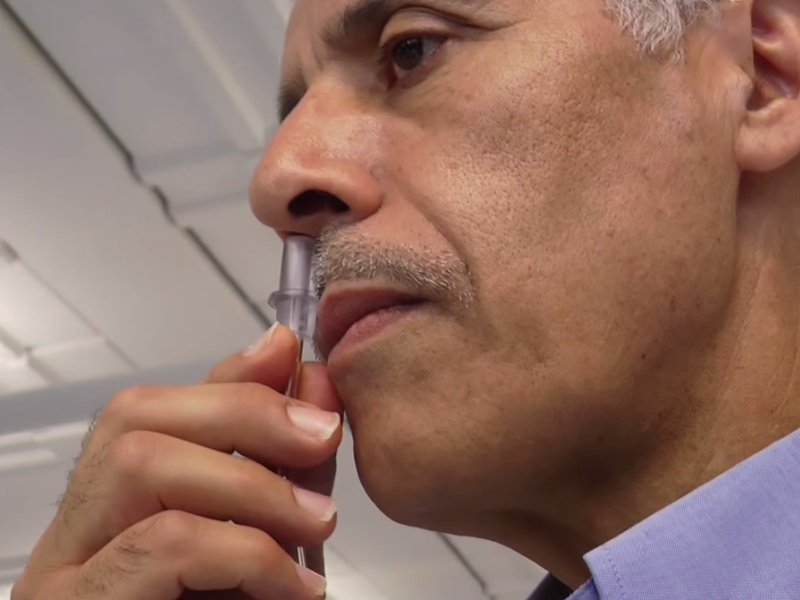- Home
- Science
- Science News
- New Device Turns Breath Into Words, Gives Paralysis Victims a Voice
New Device Turns Breath Into Words, Gives Paralysis Victims a Voice

The prototype developed by researchers from Loughborough University analyses changes in breathing patterns and converts 'breath signals' into words using pattern recognition software and an analogue-to-digital converter.
A speech synthesizer then reads the words aloud. The Augmentative and Alternate Communication (AAC) device is designed for patients with complete or partial loss of voluntary muscle control who don't have the ability to make purposeful movements such as sniffing or blinking - gestures which previous AAC devices have come to rely upon.
Dr. David Kerr, Senior Lecturer in the School of Mechanical and Manufacturing Engineering, and Dr. Kaddour Bouazza-Marouf, Reader in Mechatronics in Medicine, said the device learns from its user, building up its knowledge as it goes.
It allows the user to control how he or she wishes to communicate - effectively enabling them to create their own language by varying the speed of their breathing.
The academics have been joined in the project by Dr. Atul Gaur, Consultant Anaesthetist at Glenfield Hospital, and Loughborough mechanical engineering student Robert Green, who will work on the device as part of his final year individual project.
"What we are proposing is a system that learns with the user to form an effective vocabulary that suits the person rather than the machine," Kerr said.
"When it comes to teaching our invention to recognise words and phrases, we have so far recorded a 97.5 percent success rate. Current AAC devices are slow and range from paper-based tools to expensive, sophisticated electronic devices. Our AAC device uses analogue signals in continuous form, which should give us a greater speed advantage because more information can be collected in a shorter space of time," he said.
"This device could transform the way people with severe muscular weakness or other speech disorders communicate," Gaur said.
"In an intensive care setting, the technology has the potential to be used to make an early diagnosis of locked-in syndrome (LIS), by allowing patients, including those on ventilators, to communicate effectively for the first time by breathing - an almost effortless act which requires no speech, limb or facial movements," Gaur added.
Catch the latest from the Consumer Electronics Show on Gadgets 360, at our CES 2026 hub.
Related Stories
- Samsung Galaxy Unpacked 2025
- ChatGPT
- Redmi Note 14 Pro+
- iPhone 16
- Apple Vision Pro
- Oneplus 12
- OnePlus Nord CE 3 Lite 5G
- iPhone 13
- Xiaomi 14 Pro
- Oppo Find N3
- Tecno Spark Go (2023)
- Realme V30
- Best Phones Under 25000
- Samsung Galaxy S24 Series
- Cryptocurrency
- iQoo 12
- Samsung Galaxy S24 Ultra
- Giottus
- Samsung Galaxy Z Flip 5
- Apple 'Scary Fast'
- Housefull 5
- GoPro Hero 12 Black Review
- Invincible Season 2
- JioGlass
- HD Ready TV
- Laptop Under 50000
- Smartwatch Under 10000
- Latest Mobile Phones
- Compare Phones
- Honor Win RT
- Honor Win
- Xiaomi 17 Ultra Leica Edition
- Xiaomi 17 Ultra
- Huawei Nova 15
- Huawei Nova 15 Pro
- Huawei Nova 15 Ultra
- OnePlus 15R
- Asus ProArt P16
- MacBook Pro 14-inch (M5, 2025)
- OPPO Pad Air 5
- Huawei MatePad 11.5 (2026)
- Xiaomi Watch 5
- Huawei Watch 10th Anniversary Edition
- Acerpure Nitro Z Series 100-inch QLED TV
- Samsung 43 Inch LED Ultra HD (4K) Smart TV (UA43UE81AFULXL)
- Asus ROG Ally
- Nintendo Switch Lite
- Haier 1.6 Ton 5 Star Inverter Split AC (HSU19G-MZAID5BN-INV)
- Haier 1.6 Ton 5 Star Inverter Split AC (HSU19G-MZAIM5BN-INV)















